Mark Rouw Iowa BIG Tree: Report Jul-Dec 2023
IOWA BIG TREE REPORT FOR JULY THROUGH DECEMBER OF 2023
BY MARK ROUW, IOWA BIG TREE FIELD REPRESENTATIVE, February 20, 2024
This will be a shorter report than the previous ones since I was unable to get out to do tree work until quite late in the year. Despite fewer measured trees there were some significant trees found and a noteworthy update.
November 9th
In September I was invited by forester, Gretchen Cline, to attend the Iowa Society of American Foresters meeting in Burlington on November 8th and 9th. It turns out I had been selected to receive the Frudden Award. November 8th I presented my big tree PowerPoint program and that evening I gratefully accepted the award.
The following day, Michael Bloomer, the Administrator of Aspen Grove Cemetery, and I led a tour of the cemetery. Michael covered the history part of the tour and I handled the tree portion.
After the tour of the cemetery, and before heading home, I went to visit the 2nd largest Iowa baldcypress which stands on low ground in Aspen Grove. I don’t recall ever seeing the tree with rusty brown foliage since I’m usually visiting Burlington when the trees are bare. After a few photos of the baldcypress I headed for Des Moines.
With some good daylight left I couldn’t just drive home without checking trees along the way! I had a lead on a persimmon in Wapello so that was my first stop. I took some cursory measurements but it wasn’t especially large. Next I drove by the Louisa County Courthouse to see if the blue ash trees on the courthouse grounds were still standing. I was disappointed to see they were gone. Didn’t anyone know that these trees were blue ashes, worthy of protecting? Perhaps if I had contacted someone they would have realized the significance of the trees and they could have been saved!
My next stop was to check on a large hemlock in the cemetery at Grandview. I was glad to see the tree was still standing but disappointed to see the ends of so many lateral limbs cut off leaving long stubs. Since it was getting late, I only took time to updated the circumference and spread. Here are the dimensions of the Grandview hemlock:
Circ. 10.375’, height 71, (meas. 2014) spread 63.5’, index 211.375, rank # 5
At the meeting there was some discussion concerning whether or not the co-champion red oak in West Liberty was still standing. I was concerned because this is one of my favorite trees, so I decided to take a look for myself. It was completely dark by the time I reached West Liberty, but I was determined to learn the fate of the big red oak. The tree stands in a park, and from the parking lot I couldn’t see the tree. I headed on foot towards the oak thinking I would see it after a few steps, but I couldn’t see anything, and I was worried. Then after a few more steps, a faint image of the trunk appeared out of the darkness. Thank goodness it was still standing!
December 20th
Quite some time ago Andy Schmitz had invited me to come to Dallas Center to measure a big redbud, and it finally happened. Although the trunk divided well below 4 ½’ which necessitated a measurement at ~ 15”, it appeared to have a single trunk. We found the new state champion redbud to have these dimensions:
Circ. 7.67’ (@15”), height 25.57’, spread 37.75’, index 127.018, rank # 1
Not far from the redbud, Andy showed me an impressive Norway spruce on private property. We determined the spruce to have the following dimensions:
Circ. 11.42’, height 87’, spread 65.75’, index 240.438, rank # 17
December 21st
I decided to check on a tall cottonwood at Prospect Park along the Des Moines River in Des Moines. Although I have been aware of this tree for at least 50 years I only started measuring the tree in the last twenty years. The last time I measured this tree was November of 2021 and at that time the height was an impressive 121.67’. With only two growing seasons since the last measurement, I was not expecting much of a change in height, but I had a surprise in store. With my Truepulse 200X mounted on my tripod I was shooting to potential highest twigs and I could hardly believe the reading of 124.67’! Here are the dimensions of this exemplary cottonwood:
Circ. 19.625’, height 124.67’, spread 116’, (spread not updated) index 388.17, rank # 13
I thought I had measured a cottonwood over 124’ at Geode State Park but I was not able to match the height on a subsequent visit. Now I can say we have an Iowa cottonwood with a height surpassing 124! I’m not convinced the tree grew three feet in two growing seasons. I suspect I managed to find a higher twig, but whatever the case, I was an exciting discovery! I have measured tall cottonwoods all over the state so I find it ironic that the tallest one I have found stands less than two miles from where I grew up!
I was enthused after measuring the tallest known cottonwood in Iowa, and there was time to measure another tree if it wasn’t too far away. For many years I have been aware of a large cottonwood that stands in the backyard of a large lot along Woodland Ave. on the west side of Des Moines. A letter to the owners some time ago went unanswered. I did receive approval from a neighbor to the east who’s property line comes close to the trunk which was welcomed, but I still needed permission from the owners. I was able to talk to the owner of the property to the west and they said they would talk to the owner for me. They may have forgotten because I never heard from the owners. I had to stop several times, but this time I was finally able to talk to the owner. He likes the big cottonwood and he gladly gave me permission to measure his tree! Here are the dimensions of the cottonwood:
Circ. 20.21’, height 101.08’, spread 109.29’, index 370.904, rank # 24
Although the spread dimension is impressive, I wish I could have measured it before a very large limb was damaged and removed. Had that limb still been present the spread would have been considerably greater.
December 23rd
When I attended the Iowa Society of American Foresters meeting in Burlington I had the pleasure of meeting, in person, Bailey Yotter with the National Wild Turkey Federation. Bailey is a fellow big tree enthusiast, and she contacted me in June with some leads on big trees.
One of the most intriguing leads was a heads up on big downy serviceberries (Amelanchier arborea) at Quercus Wilderness in Mahaska County. I thought about visiting this site numerous times, but I knew it would be best to wait until the trees were bare. Finally it worked out for me to visit Quercus Wilderness. After arriving, I followed a paved trail to the west which didn’t go far. Just beyond the end of the trail I noticed a couple of fair sized serviceberries, but they weren’t of the size I was hoping to find. Bailey had mentioned there were big ones visible from the trail and I couldn’t help thinking , this may be a wild goose chase. I continued on a dirt trail for quite some distance but there were no big serviceberries to be seen! I headed back to the parking lot where I took another trail which headed to the south. It didn’t take long before the biggest Amelanchier arborea I had ever seen appeared before me right along the trail! After measuring this tree, I continued on the trail in search of more big serviceberries. Although the first tree was the largest one I found, I measured five serviceberries which were significant. I was busy measuring the last tree until it was too dark to continue.
December 24th
I was so impressed with Quercus Wilderness, I returned the following day to measure more serviceberries. I hiked in a loop clear to the west end of the park but most of the big serviceberries appeared to concentrated in the southeast corner. I documented the size of five more serviceberries and before I finished measuring the last one for the day, I was measuring by moonlight!
A herpetological observation may be of interest to some of those who read this report. The day before my visit to Quercus Wilderness, the area received about .75 inches of rain which was significant during this period of drought. Much to my surprise, on both December 23rd and 24th, I heard numerous calls from a small frog species called the spring peeper. I never imagined I would ever hear frogs calling on Christmas Eve in Iowa!
After about twelve hours of searching and measuring over two days, I located ten Amelanchier orborea at Quercus Wilderness that were larger than the largest one listed on the Iowa Big Tree Spreadsheet!
Here are the dimensions of the three largest downy serviceberries measured at Quercus Wilderness:
Circ. 3.71’, height 51.83’, spread 27’, index 102.955, rank # 1
Circ. 3.04’, height 51.25’, spread 24.5’, index 93.875, rank # 2
Circ. 2.58’, height 56.5’, spread 24.25’ index 93.563, rank # 3
Eight of the measured serviceberries were taller than 42’ which was the old height record for this species in Iowa. With a height of 56.5’ the third tree listed above has the greatest height.
December 28th
Today I met state forester, Joe Herring at Hollingsworth Timber in Marshall County to check out a large elm that was believed to be a red elm. After a close examination I determined the tree was an American elm. If it had been a red elm it would have been a new champion, but even for an American elm, it was significant, and warranted measuring. Here are the dimensions of the American elm at Hollingsworth Timber:
Circ. 13.375’, height 93’, spread 103’, 98’, index 278, rank # 13
The 2020 derecho hit this area pretty hard and there were many downed trees at this site. The big elm fared better than many other trees but it did suffer substantial damage on the west side of the crown which reduced the spread.
After measuring the elm, I headed to Franklin County to check out a reported large oak. Carol, the person who reported the tree called it a pin oak, but based on photos from Carol, I determined it was a black oak. I met Carol at her home and then we drove to the pasture where the black oak stood. Here we met with the owner Molly. Unfortunately, the circumference of the oak was considerably less than what was reported so it didn’t hold much interest for me.
However, not far from the oak stood a very old looking dotted hawthorn. initially I dismissed the tree because the trunk divided at perhaps 3’ above the ground, and I figured it was likely two merged trunks. After looking at the black oak, I was invited to take a walking tour of the rest of the pasture. Listening to the owner of the property, it didn’t take long to find out she and her husband had a disdain for the dotted hawthorns which they referred to as thorn trees. In fact, for years the owners husband had been dedicated to removing nearly all of the hawthorns on the property. Except for the one near the black oak, only a few hawthorns had been left at the edge of small patches of timber along the creek. After the tour we arrived back near the old dotted hawthorn with two trunks. It turns out that tree had been slated to be cut some time ago, but inexplicitly it was still standing! I’m hopeful that now it has been recognized as a state champion that it won’t be cut.
After a closer look at the tree, I realized even if only one of the trunks were measured it might qualify as a new champion. After measuring the west trunk it was time for photos but neither of my new acquaintances were willing to pose by the hawthorn. It was getting late and the lighting was already poor. The thought of handling the metal tripod with my fingers already hurting from the cold wasn’t very appealing. After all, I didn’t even know if the tree was that significant. I settled for a photo of the tree with my backpack next to the trunk. I did take a couple of photos of the trunk with my phone. After studying the photos it looks like it may actually qualify as a single trunk, but if so, the circumference would need to be measured quite low, perhaps at about 18”.
Several hundred yards to the north I could see acres of dotted hawthorns covering the bottomland adjacent to Buffalo Creek. I pointed them out to Carol, and suggested maybe she could scout out those trees for me now that she would be able to identify the species. She commented, ”they look like gray smoke”, to which I agreed. I don’t see dotted hawthorns in central Iowa, but in Franklin County they appear to be a abundant, at least along the streams. Later when I checked the spreadsheet, I determined the hawthorn did qualify as a new state champion, even though only one trunk was measured! Here are the dimensions of the newly crowned champion dotted hawthorn:
Circ. 3.54’, height 25.92’, spread 33’, index 76.67, rank # 1
December 30th
For a many years my wife Rita and I used to go birding at Lake Red Rock during the winter. We were mainly interested in counting eagles, but like always, we kept a list of all bird species. From a housing development near the Damn, I always noticed what appeared to be a large shagbark hickory in the distance. I attempted to reach the tree a few years ago but I was unable to locate it with the time I had. I decided to try once again, and this time I was successful. Sometimes trees exceed your expectations and sometimes they don’t. The tree did not meet my expectations so I decided not to measure the tree which gave me time to look elsewhere.
Not far from my previous stop, I was driving by some timber, and I started seeing trees that looked older and bigger than those in typical woodlands. After scouting out the several acres that had older trees, there was a bitternut hickory that stood out. I found the bitternut hickory to have the following dimensions:
Circ. 7.33’, height 103.75’, spread 49’, index 205, rank # 5
Bitternut hickories are having problems, and it is becoming more difficult to find large specimens. This one, however appears to be in relatively good shape.
December 31st
I grew up on the north side of Des Moines, and in the 1960’s there were still some big American elm trees around. One of the biggest elms in my part of town stood at the edge of the athletic field east of Harding Middle School. Interestingly, there was also a very large cottonwood just south of the School. The elm tree was lost due to Dutch Elm Disease, circa 1970, and several years later the cottonwood was removed to accommodate an addition to the school. No one else seemed to care, but I sure missed those big trees! On private property just east of the athletic field stood a well formed honey locust, but it wasn’t too big. Over the years I kept an eye on the tree, and recently I decided to take a close look at the tree. I was quite surprised to find the tree had become quite large!
I measured the honey locust and determined it had the following dimensions:
Circ. 14.33’, height 76’, spread 92’, index 271, rank # 4
After seeing just how big that honey locust had become, I started thinking about a couple of others in Des Moines. Perhaps they were larger than I realized as well. I headed to one of these trees that stood in the same neighborhood as the cottonwood I measured ten days earlier. The owners were home, and I received permission to measure the tree. Although it was getting late, I had just enough time to determine the following dimensions of this impressive honey locust:
Circ. 13.92’, height 92.42’, spread 98.25’, index 283.983, rank # 3
This honey locust turned out to be considerably larger than I had anticipated!
The following contains photographs of some of the trees mentioned in this report.
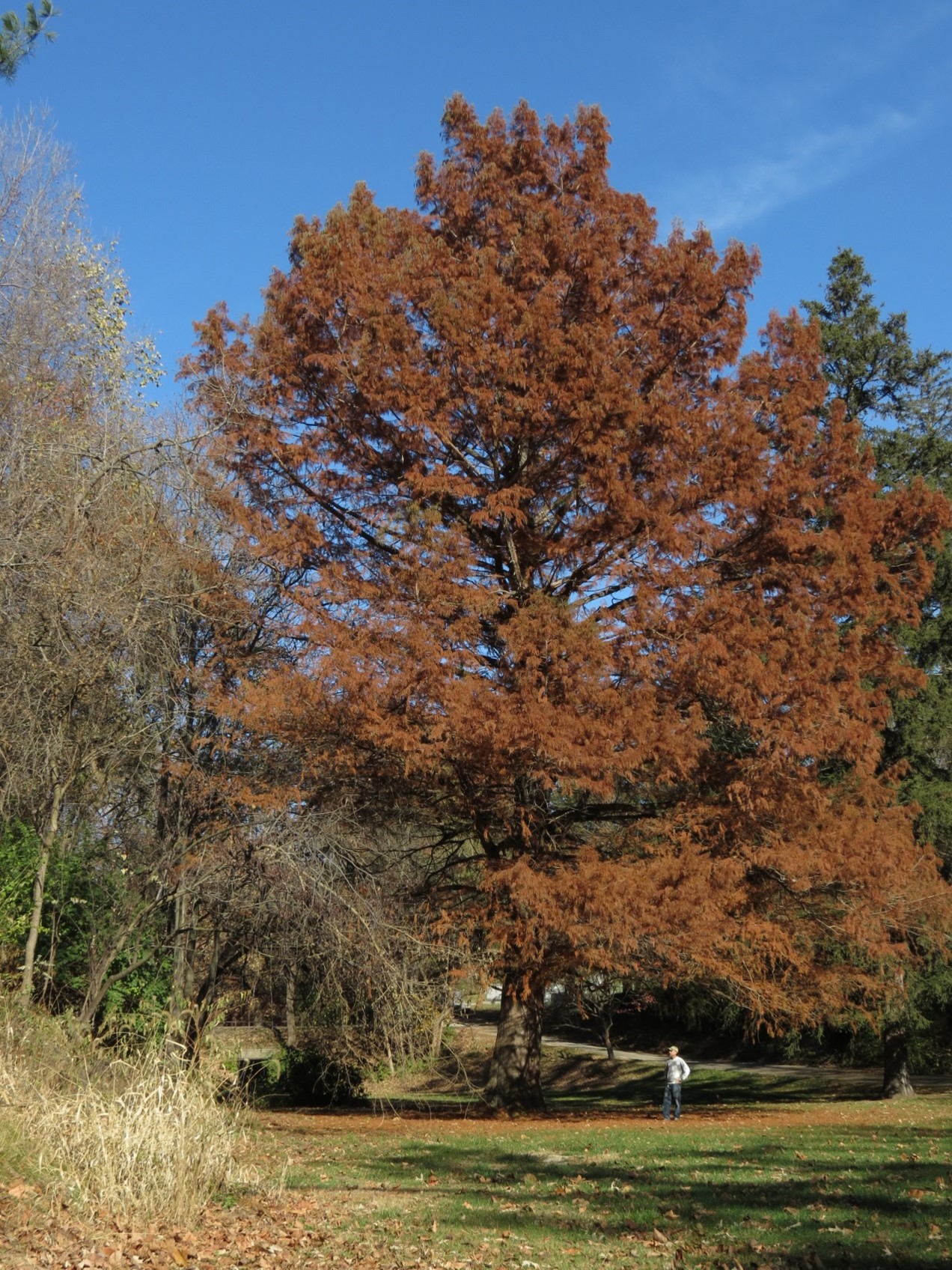
This baldcypress in Aspen Grove Cemetery is only 6 points smaller than the number one tree also located in Burlington. Because it within 3 percentage points it qualifies as a co-champion.
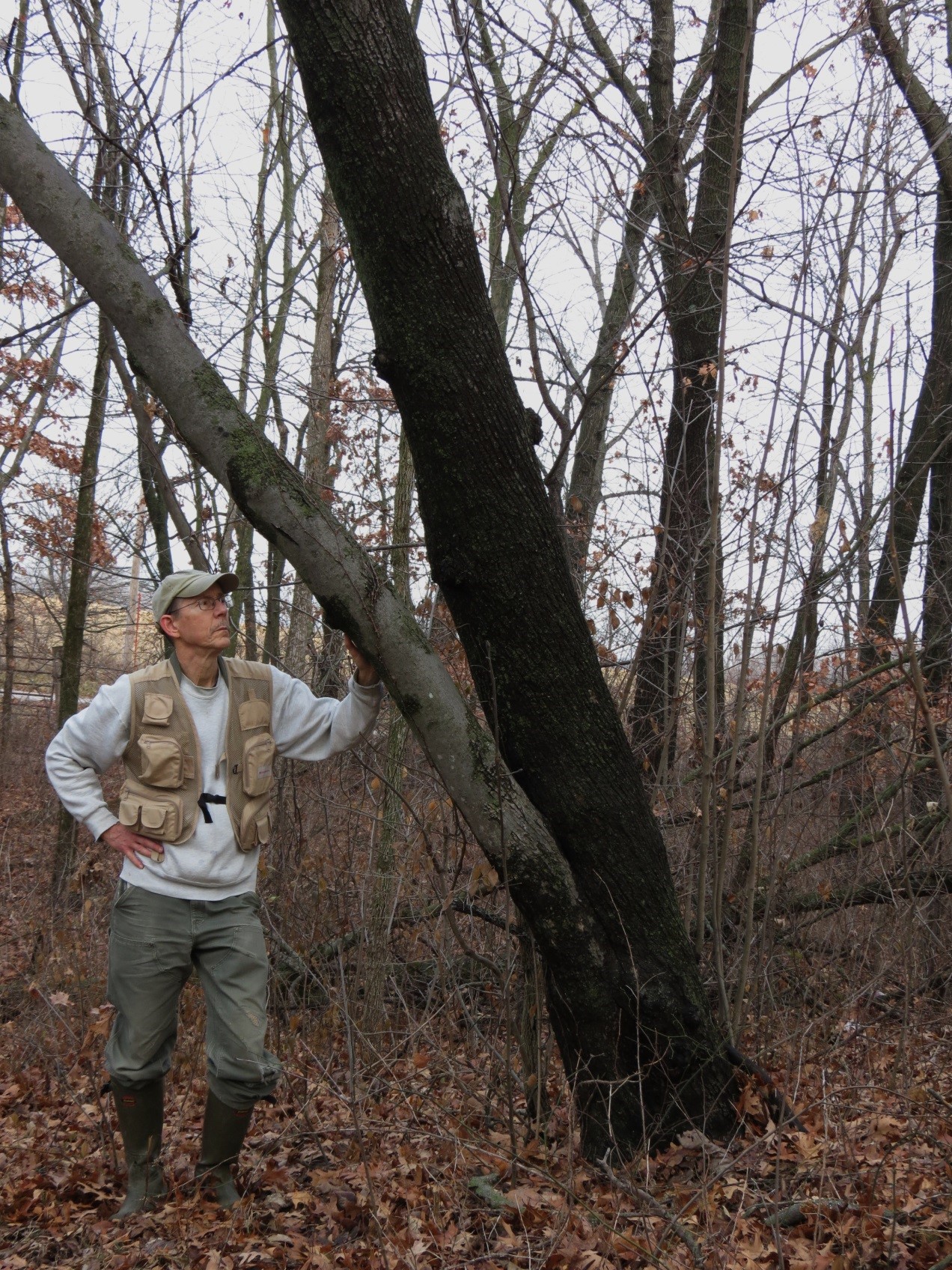
This recently documented champion downy serviceberry, (Amelanchier orborea) is located at Quercus Wilderness in Mahaska County. Ten specimens were found here that exceeded the size of the former champion!
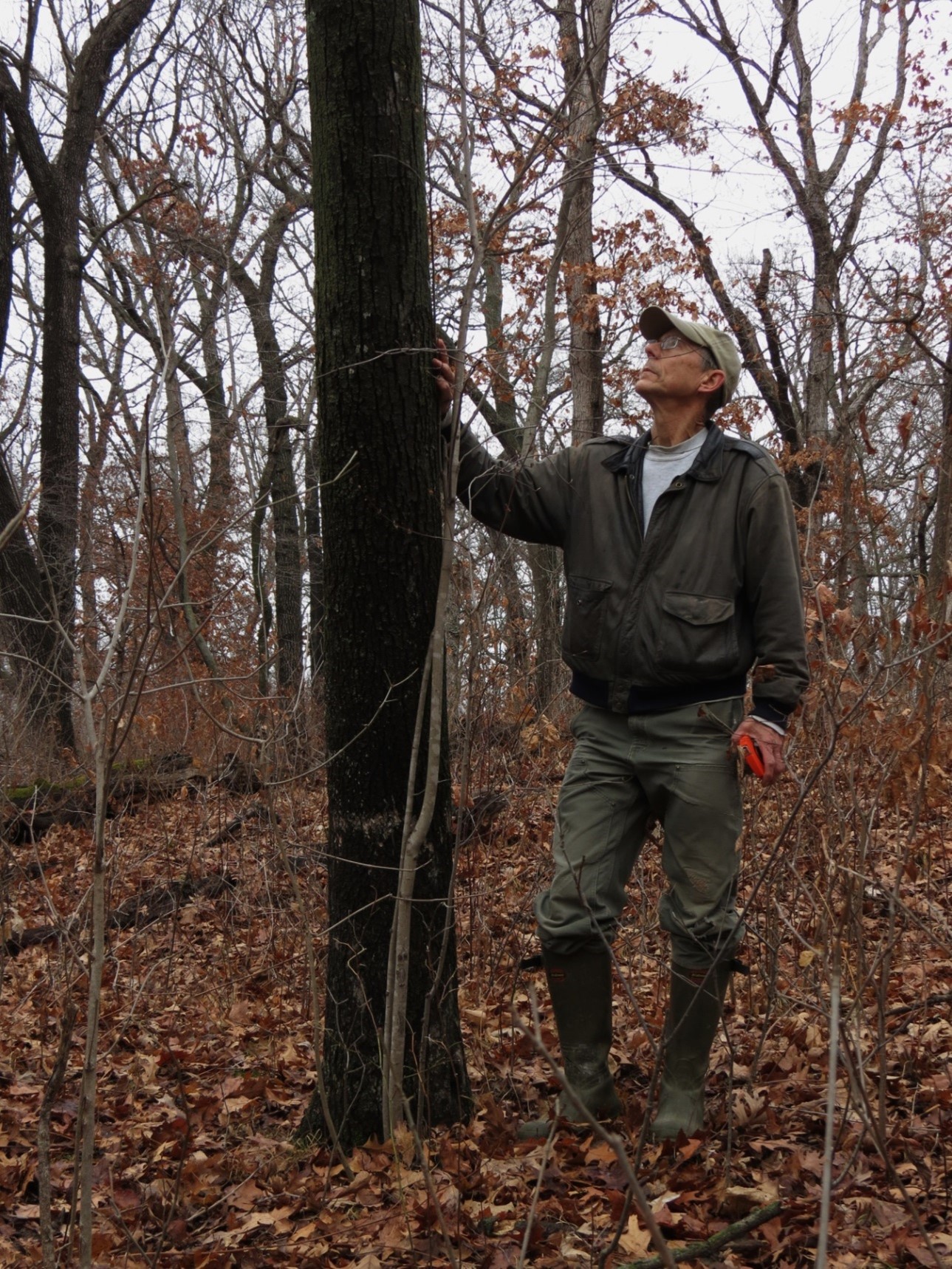
Standing 56.5’ tall this downy serviceberry at Quercus Wilderness holds the height record for the species in Iowa.
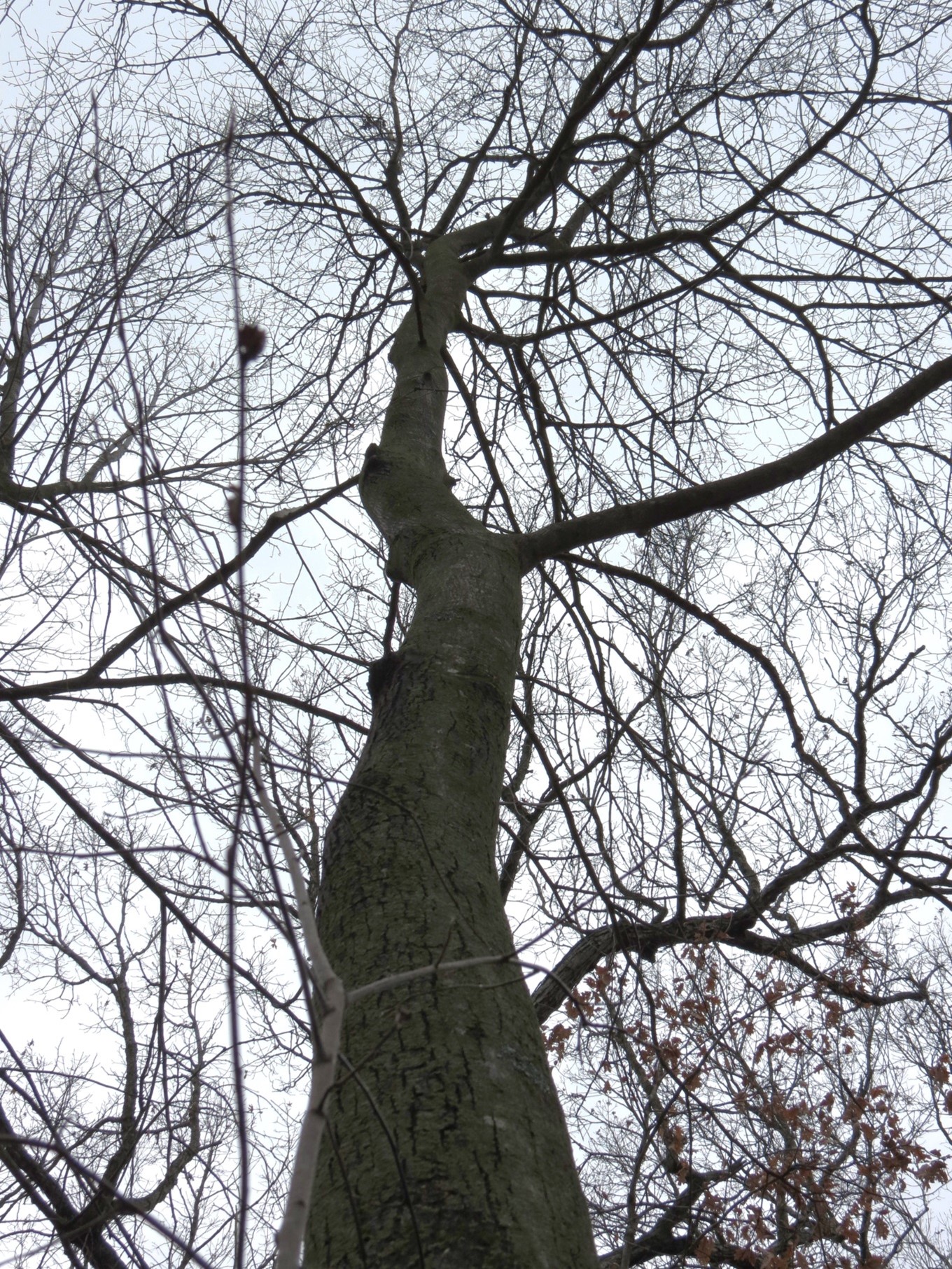
Here is another photo of the tallest known Iowa downy serviceberry.
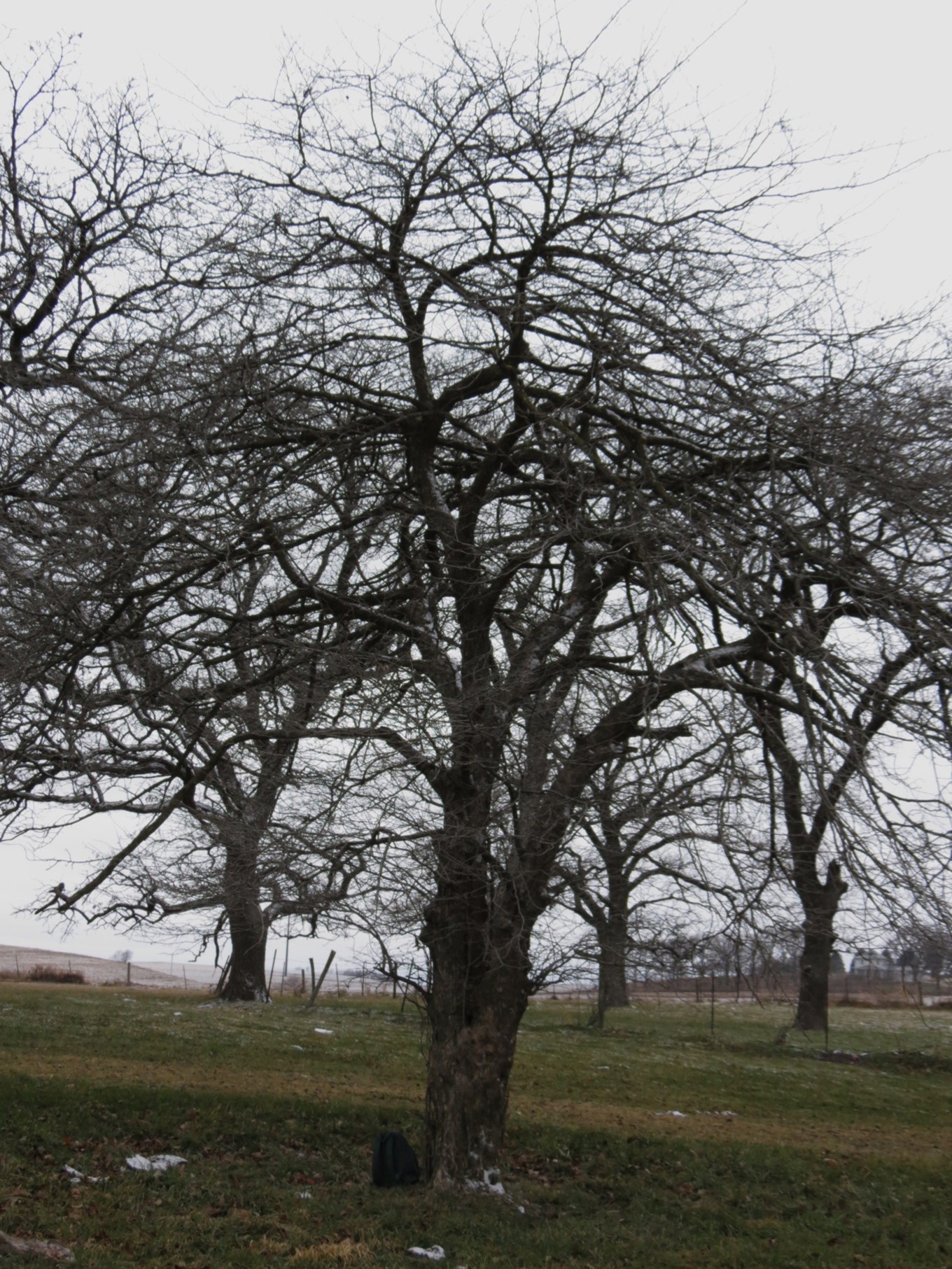
This is the largest known dotted hawthorn, Crataegus punctata, located in Franklin County. Only the left trunk was measured. My backpack is next to the trunk for scale.
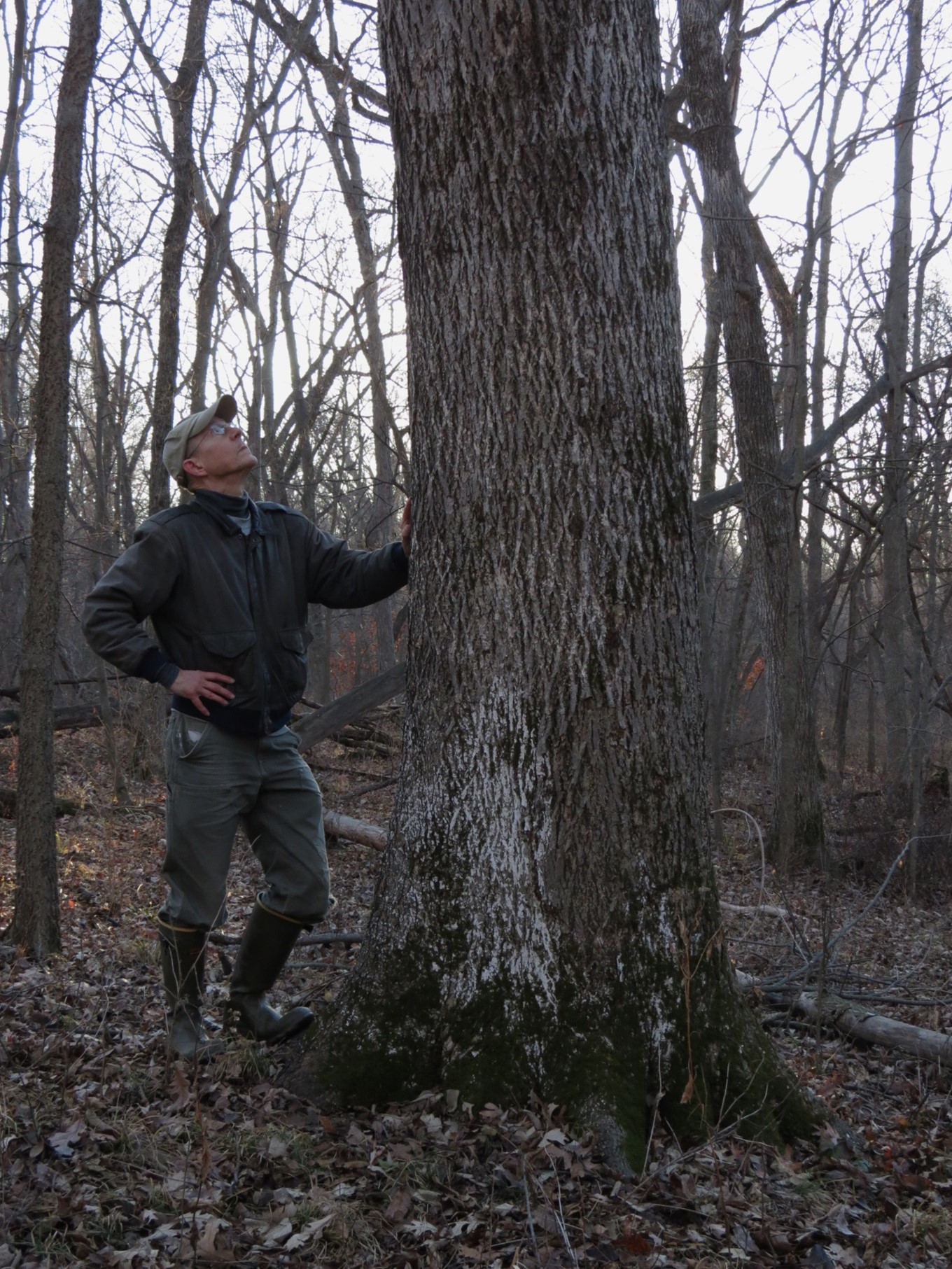
I found this bitternut hickory on public property on the north side of Red Rock Reservoir.
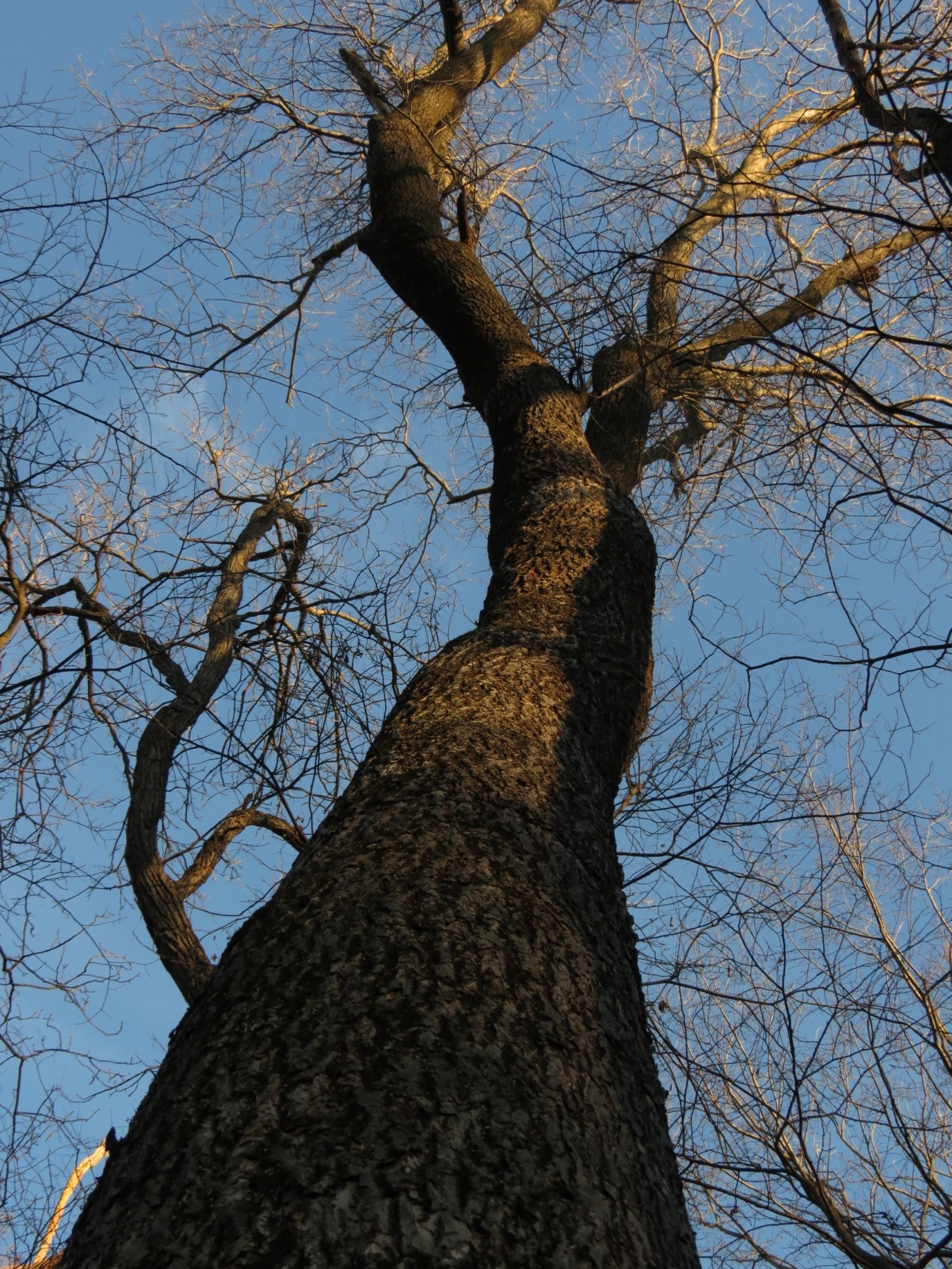
Here is another photograph of the 5th largest known bitternut hickory I found near Lake Red Rock. It reaches a height of 103.75’.
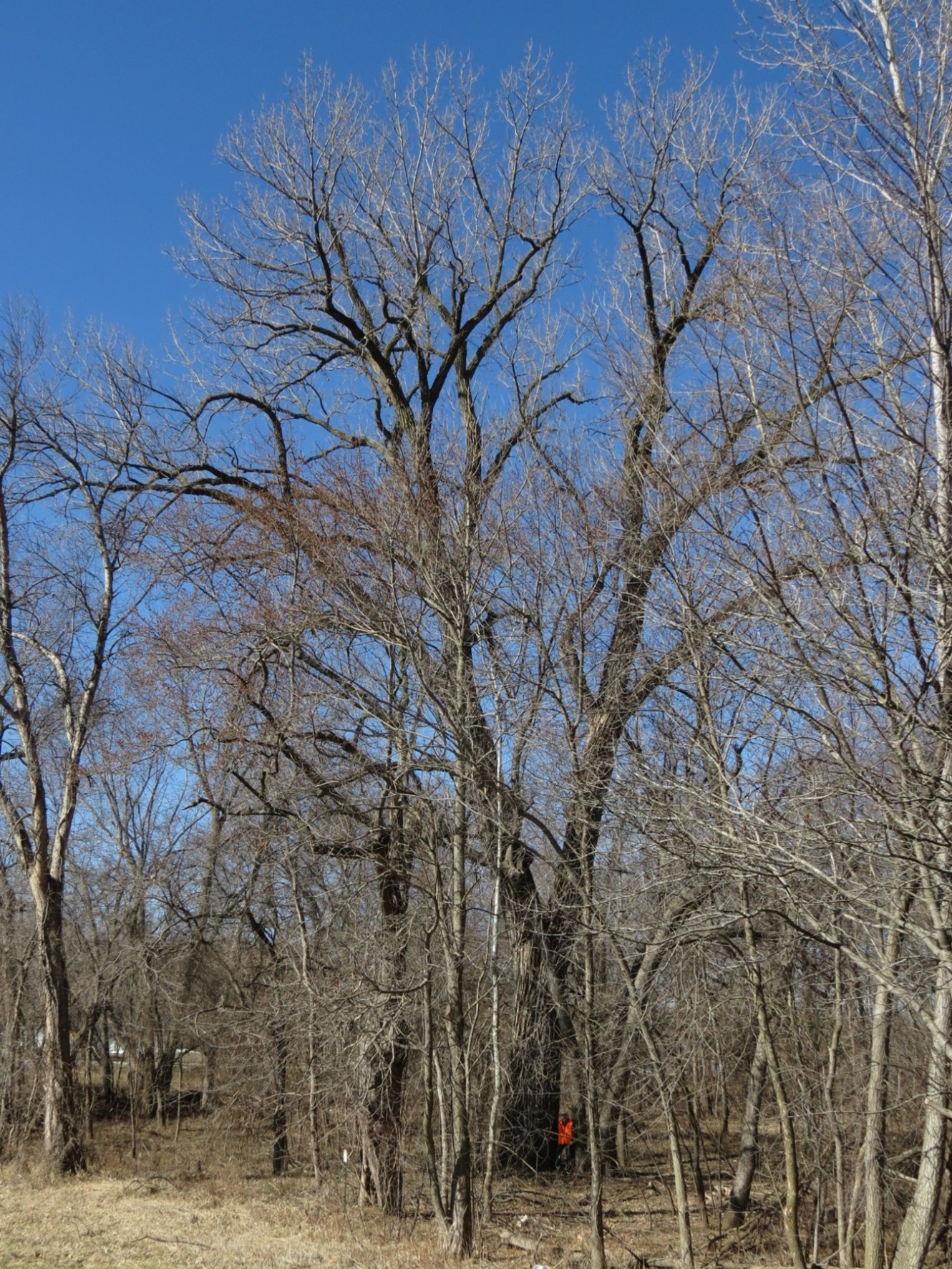
Standing 124.67’ this cottonwood that lives near the Des Moines River on the north side of Des Moines has the greatest height of any known cottonwood in Iowa!
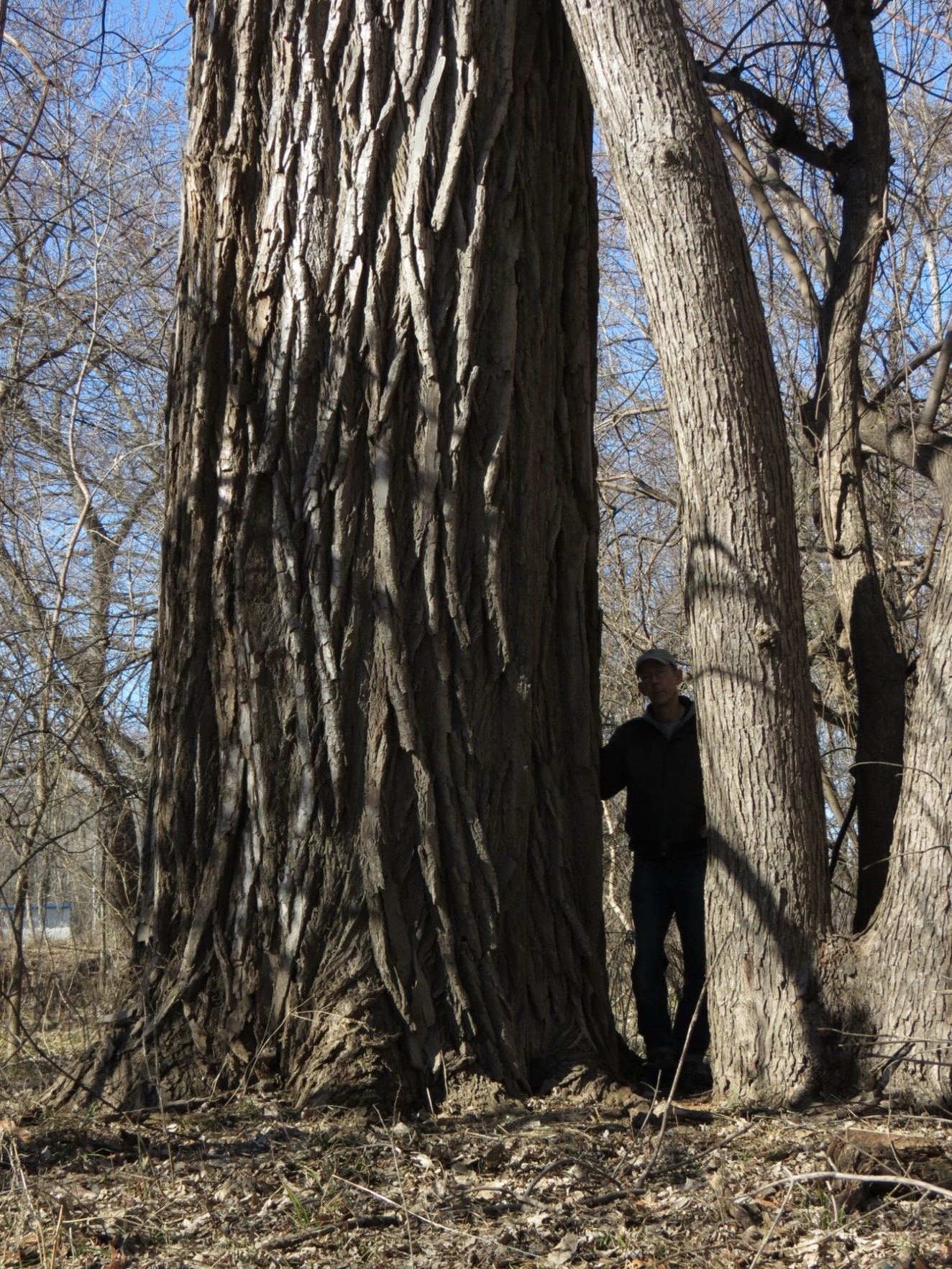
The tallest cottonwood has a very respectable trunk circumference of 19.67’.

A different viewpoint of the tallest cottonwood.
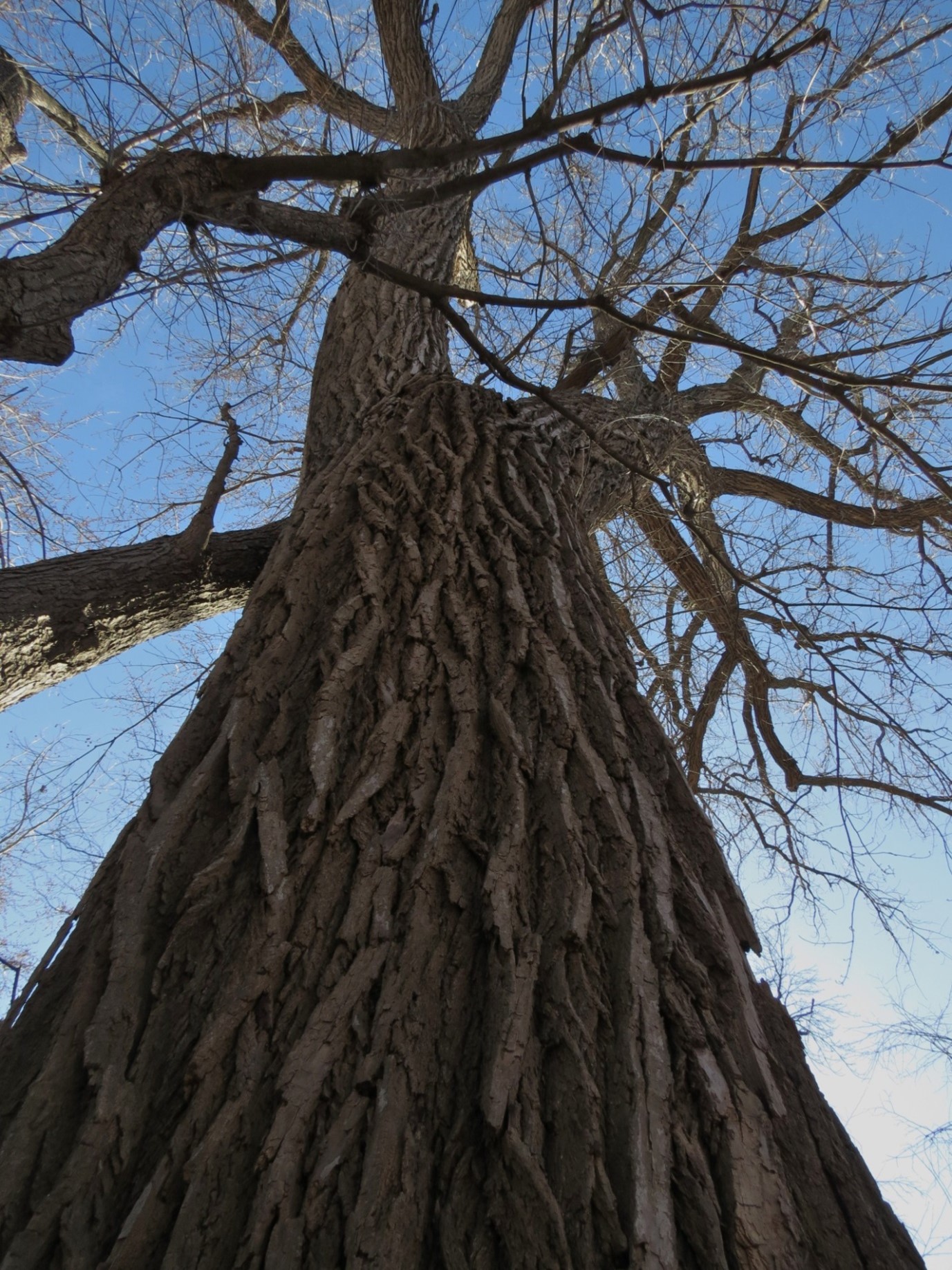
Here is another view of the tallest cottonwood.